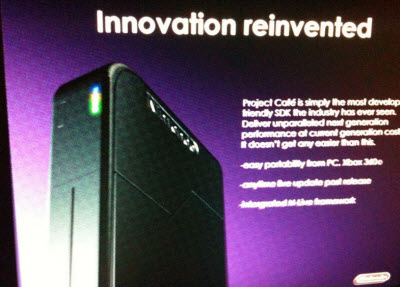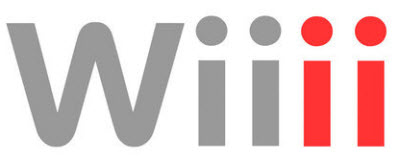 Nintendo isn’t in the habit of asking journalists for advice about its consoles. But here’s some unsolicited advice about what I would like to see in a next-generation video game console. It’s good to bring this up now because, as the leader in the Wii generation, Nintendo’s choices will likely influence the other players in the industry and determine the pace of innovation in video games for years to come.
Nintendo isn’t in the habit of asking journalists for advice about its consoles. But here’s some unsolicited advice about what I would like to see in a next-generation video game console. It’s good to bring this up now because, as the leader in the Wii generation, Nintendo’s choices will likely influence the other players in the industry and determine the pace of innovation in video games for years to come.
Nintendo confirmed last night that it would launch a new console in 2012 and show a working prototype at the E3 trade showing in June. The machine will be critical to whether Nintendo hangs on to its No. 1 position in video game console hardware. The video game industry will pin much of its hopes for sustained growth on Nintendo’s plans.
The company faces unprecedented competition for the entertainment time of its audience from new competitors, such as games on Facebook, smartphones and the tablets. So its choices will be very important to the future health of console gaming. While some features of the device have leaked out, Nintendo still has some leeway to make changes to the system in terms of the hardware that goes into the box, since the machine isn’t expected to debut until the fall of 2012. (Nintendo confirmed 2012, but it did not confirm the particular season or month).
The 2006 launch of the Wii will go down as one of the smartest and most-disruptive events in the history of video games, as it propelled Nintendo from No. 3 in consoles to No. 1. Let’s hope that Nintendo hasn’t lost its knack for shaking things up. Here’s my own wish list for what Nintendo should do.
AI Weekly
The must-read newsletter for AI and Big Data industry written by Khari Johnson, Kyle Wiggers, and Seth Colaner.
Included with VentureBeat Insider and VentureBeat VIP memberships.
1. Developer feedback. Nintendo should share its prototypes with developers early and get their feedback. In past generations, Nintendo hasn’t done this as well as Microsoft, which found an opening for its original Xbox because developers felt they had been ignored by the established vendors. Nintendo has often sought opinions from its own game developers, but not as much from third-party companies because of the need for secrecy. But that’s why some Nintendo products have been weak on features. Nintendo is already reportedly consulting with game designers, in secret, but it doesn’t hurt to reinforce how critical this point is for a console’s success.
 2. A touchscreen user interface. Nintendo’s code-named Project Cafe console is rumored to have a game controller with a 6-inch touchscreen. That sounds like a good idea because Apple’s iPad and iPhone have proven to be very appealing to non-gamers who would never otherwise pick up a game controller. The game controller itself could be detached from the system and possibly used as a handheld device. The problem is that a touchscreen controller is expensive, costing as much as the game console itself. Nintendo is also reportedly allowing the use of its current Wii Remote motion-sensing controller for some games as well.
2. A touchscreen user interface. Nintendo’s code-named Project Cafe console is rumored to have a game controller with a 6-inch touchscreen. That sounds like a good idea because Apple’s iPad and iPhone have proven to be very appealing to non-gamers who would never otherwise pick up a game controller. The game controller itself could be detached from the system and possibly used as a handheld device. The problem is that a touchscreen controller is expensive, costing as much as the game console itself. Nintendo is also reportedly allowing the use of its current Wii Remote motion-sensing controller for some games as well.
3. Better graphics. The machine needs as much processing power and 3D graphics capability as possible. The Wii fell short on this front, and that’s why Nintendo has begun to lose the hardcore gamers to the Xbox 360 and the PlayStation 3, which were both able to display high-definition graphics from the outset. The rumors suggest that Nintendo’s new machine will be able to handle HD, but the question is, how much faster than the Xbox 360 and the PlayStation 3 will it be? The processor and graphics chips are the most expensive components in a game console, so there’s a trade-off between performance and cost. But Nintendo shot too low on performance with the Wii. It only succeeded because of the disruptive motion-sensing controller that went with the Wii. I love to entertain guests with the simple motion-sensing fun of the Wii. But I’d love to be able to play a realistic 3D game with the quality of id Software’s Rage or Sony’s Uncharted 3 on a Nintendo console. The hardcore audience wants stuff like this, and there is no need to leave us behind as Nintendo pursues its broader audience of non-gamers at the same time. The good thing is that HD graphics don’t cost nearly as much as they once did.
4. Better storage options. Nintendo’s new console will reportedly handle downloadable content, downloaded from a web-connected app store. The Wii had such pitifully small storage that downloadable content really seemed like an afterthought. But the Xbox 360 and PlayStation 3 are really shining now for enabling the online business models that go with digital downloads. Nintendo has to catch up on this front, probably by putting lots of flash memory and a hard disk into the system.
Flash memory enables the instant-on operation of devices such as the iPad and the MacBook Air, which have set the standard for fast wake-up. A hard drive, meanwhile, could store downloadable games and a collection of recorded TV shows and movies. But Nintendo should also keep in mind the next consideration.
5. Game streaming. The device might not need beefy hardware components if it relies more on streaming technology, such as the kind that has been developed by Gaikai, Otoy, Playcast, Spoon and OnLive. With streaming, the processing is done in the web-connected data centers, or cloud, and sent down in video snippets to the user’s machine over a broadband connection. With streaming, a hard drive isn’t absolutely necessary. And the streaming technology can reduce the need for a high-end graphics chip or processor. The only requirement is that the user absolutely has to have a decent broadband connection to the machine. The benefit of a streaming device is that Nintendo may never have to upgrade its console again. If it needs to improve the graphics or other technology, it can do a big upgrade in the data center.
6. New kinds of motion control. Nintendo led the way with the Wii Remote when it comes to fun new ways to control a game. It was dismissed as a gimmick, but Nintendo sold more than 86 million Wii consoles since 2006. Nintendo beefed up the accelerometer and infrared control systems in the Wii by launching the Wii Motion Plus, an add-on with gyroscope technology. Sony upped the ante last fall with the PlayStation Move. And Microsoft went controller-free with the launch of the Kinect motion-sensing system in November. Kinect uses a 3D depth camera to sense your position and movement in a room, so you don’t need a controller at all.
But Kinect has the problem of latency (slowness) and accidental gestures. I think that a combination of old-fashioned buttons, a handheld device like the Move, and the Kinect hands-free technology would be a big improvement for accurate, fast, and user-friendly control of games.
7. Disruptive video game business models. Digital gaming has disrupted the traditional console markets, and the big companies need to respond. Free-to-play games on the smartphone, tablets, the web and Facebook are stealing consumers away. It is entirely possible to accommodate these more flexible business models such as free-to-play — where users play for free and pay real money for virtual goods such as better weapons in microtransactions — on a game console. This doesn’t require any extra hardware, but it makes the console and its games more affordable to wider groups of consumers. That has always been one of Nintendo’s goals.
8. Better social networking. Microsoft has Xbox, Live and Sony has the PlayStation Network. But both of those online services were created in the days before the rise of Facebook and Twitter. Now that those giants are in the market, the social networking features for a connected game console should be built directly into a system. Social networks make people feel more welcome, and that gets them to stay longer. And if they stay longer, they can discover new games with their friends and play them more often. Social gaming is something that the consoles can embrace, as long as they do it in a hassle-free way for gamers. At the same time, Nintendo will have to figure out a way to protect kids, who are its core audience.
9. Low prices. I know. I’ve asked Nintendo to pack all of this stuff into its console, and yet I see the benefit of having a low entry price that will enable Nintendo to reach the mass market. It would be very tempting and possibly financial necessary for Nintendo to price this machine at around $350 to $400. That’s around the price range where Microsoft launched the Xbox 360, but it’s a higher price than Nintendo typically uses for launches. If Nintendo can find a way to launch at a lower price, possibly by using the streaming technology mentioned in No. 5, it has a chance to disrupt the market.
10. Skip the stereoscopic 3D. The 3DS isn’t so bad once you get used to it, but stereoscopic 3D isn’t up to snuff when it comes to high quality on a big screen. Nintendo has wisely said it will not likely do stereoscopic 3D on a big screen, but Sony has been diving into it in a big way. We don’t want Nintendo to repeat Sony’s mistake. 3D is a gimmick to sell new TVs. It just doesn’t work well, adds costs, and makes a lot of users dizzy.
Which one of these ideas do you like the best? Let us know by voting in the poll and writing a comment.
Online Surveys – Zoomerang.com
VentureBeat's mission is to be a digital town square for technical decision-makers to gain knowledge about transformative enterprise technology and transact. Learn More